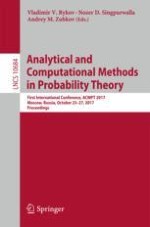2017 | Buch
Analytical and Computational Methods in Probability Theory
First International Conference, ACMPT 2017, Moscow, Russia, October 23-27, 2017, Proceedings
herausgegeben von: Dr. Vladimir V. Rykov, Nozer D. Singpurwalla, Andrey M. Zubkov
Verlag: Springer International Publishing
Buchreihe : Lecture Notes in Computer Science
